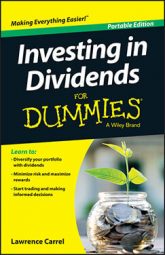With growth investing, you buy stocks in companies with earnings and revenue growth rates that exceed the market average in anticipation of big jumps in the share price; these stocks are typically young or small companies that reinvest their earnings to maximize growth and typically don't pay dividends.
Growth investors are like scouts for professional sports. Their job is to evaluate the up and coming talent and identify the most promising athletes. Growth investors want to see companies with potential — companies that are growing faster than the competition and other companies in their industry. They're interested in companies that plow every penny of profit back into the company to fuel future growth. Because of this focus, growth investors care little or nothing about dividends.
Don't confuse growth with share price appreciation. Growth is a measure of a company's earnings and revenue increases relative to similar companies. Share price merely reflects what investors are willing to pay for the stock, which may have nothing to do with the company's actual performance.
Growth stocks get their moniker if their earnings and revenues grow at a faster pace than their particular end of the market. For instance, a large-cap stock growing at a faster rate than the S&P 500 is considered a growth stock. Small-cap stocks have to show a greater growth rate than the index for the small-cap market, the Russell 2000, to be considered growth stocks.
Large-cap is short for large market capitalization. Small-cap is the abbreviation for small market capitalization. Market capitalization is a fancy phrase for a company's market value, determined by multiplying its share price by its number of outstanding common shares. The definitions aren't set in stone, but currently, a large market cap is greater than $10 billion. A small market cap is between $300 million and $2 billion.
Because the focus is on growth, certain measures, including a company's price-to-earnings ratio or price-to-sales ratio carry less weight. Growth investors are more concerned with how the company did this quarter compared with how it performed in the quarter 12 months earlier. Here's the formula:
Growth Rate = (This Year's Profit – Last Year's Profit) / Last Year's Profit
For example, say Dubois Foods earned $1 million last year and $1.25 million this year:
($1.25 million – $1 million) / $1 million = 25 percent
Growth investors generally evaluate growth stocks based on the following criteria:
Earnings and revenue growth rates higher than the broader market and other companies in the same industry: Growth rates should be at least 10 percent. If the earnings growth rate is faster than the revenue growth rate, the company is also keeping costs down.
Consistent growth rate for several consecutive years: A one-year jump is a fluke. Five years of consistent growth is a trend.
Growth investors aren't scared by P/E (price-to-earnings) ratios in the 20s, 30s, and 40s, which means the price of each share is 20, 30, or even 40 times higher than each share is earning. If the earnings are growing fast enough, the price is warranted.
Comparing this year's results to last year's results provides the annual growth rate, but what if you're in the end of the third quarter? Over nine months, a lot can change. Are those numbers still relevant? The most recent growth rate compares the most recent fiscal quarter to the same fiscal quarter last year. The reason you compare the current quarter to the year-ago quarter is that business can be cyclical. Ice cream shops sell a lot more in the summer than the winter. So comparing this summer quarter to the year-ago summer quarter gives you a better comparison of a company's growth because business conditions should be similar.

